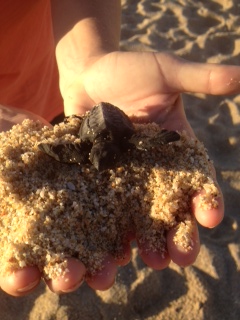
If you are walking the beaches around Los Cabos at the moment and you keep your eyes open you can expect to see some baby turtles hatching. There are several release programs in Cabo and it is a great treat if you are here with your kids to take part in one. Indeed, for kids of all ages, this is a wonderful way to connect with the amazing wildlife we have around Los Cabos.
Most releases take place in the fall which coincides with the annual whale migration and youngsters are invited to participate in co-operation with the local conservation programs.
The main turtle species represented in the program are Olive Ridley turtles and Leatherback turtles. Olive Ridley females nest in Los Cabos from June through December, Leatherback females from November through February.
After a two month incubation process, hatchlings claw their way out of the nest and instinctively head straight towards the sea. Unfortunately, many are eaten by birds and crabs before they reach the water, and those that do make it often fall prey to fish. Increasing beach development is also a major problem, as they are programmed to head of the brightest light – normally the reflected light from the sea. However, lights from hotels and beach homes disorient the baby turtles and draws them away from the relative protection of the waves. Nursery programs have therefore become hugely important for sea turtle survival rates because from every batch of eggs laid by the female, only one or two will survive to maturity and return to breed on the same beach that they hatched.
Turtles are protected by Mexican law and those protected in the Baja are; Leatherback, Olive Ridley, Hawksbill, Loggerhead and Eastern Pacific Green Turtles.
Pedregal beach is a favorite spot with many nests and is easily accessible from downtown Cabo.